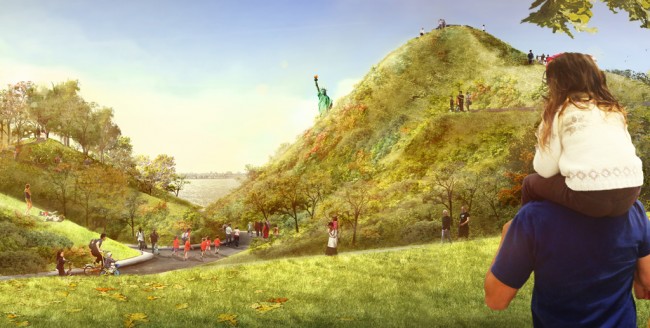
We are celebrating 15 years — and counting — of stories that are deeply researched and deeply felt, that build a historical record of what the city has been.
We are celebrating 15 years — and counting — of stories that are deeply researched and deeply felt, that build a historical record of what the city has been.
THE WAITLIST FOR PUBLIC HOUSING
While New York City has some of the highest concentrations of public housing in the country, the demand for a subsidized apartment still far outstrips the supply. This year, 227,000 applications were submitted to NYCHA, a number which, for the first time, surpasses the 178,900 public housing apartments that exist in the city. Applicants are vying for the few 5,400 to 5,800 spaces that open up each year, and their position on the waitlist, which is not first-come-first-served, is never known or secure.

Harvest Dome | Image via SLO Architecture
HARVEST DOME RETURNS
The Harvest Dome is back in production, after the first rendition broke free from its moorings on the East River and crashed into Rikers Island two years ago. The designers behind the installation, SLO Architecture (who spoke with us about their work along the Bronx River earlier this year), are constructing the 24-foot-diameter dome out of 400 discarded umbrellas and floating it atop 128 2-liter soda bottles, all of which were collected from the city streets and waterfronts, in order to draw attention to the city’s polluted waterways. Harvest Dome will launch on August 1st at Inwood Hill Park inlet and will remain on the water for the month of August. You can track the installation’s progress here.
KEEPING THE FAUCETS FLOWING
The latest piece of Water Tunnel No. 3, the largest infrastructure project in the city’s history, is coming online in Manhattan, bringing much needed redundancy to the city’s water supply. Until now, the borough’s water supply has been provided by a single, aging tunnel that, because it has been in continuous use since its construction in 1917, has never been fully inspected or repaired. (Water Tunnel No. 2, which was completed in 1936, runs from the Bronx into Queens, Brooklyn, and Staten Island, and does not serve Manhattan.) The entirety of Tunnel No. 3, which has been under construction since 1970, is scheduled for completion in 2018.

The Hills, Governors Island | Photo courtesy of NYC Mayor’s Office
THE HILLS
Mayor Bloomberg broke ground yesterday on The Hills, the latest piece of park in Governors Island’s transformation from military base to public space. Designed by landscape architecture firm West 8, the 11-acre site will feature four large hills constructed out of recycled construction material, including debris from a building that was razed on the island earlier this year. The tallest will rise 80 feet and provide panoramic views of the Lower Manhattan skyline and New York Harbor.
THE BUS MAYOR
This week, City Council Member Brad Lander introduced a bill to expand and formalize a citywide plan for Bus Rapid Transit, encouraging the next mayor to claim the title of “the bus mayor” to follow Mayor Bloomberg’s designation by some as “the bike mayor.” Mayoral hopeful Christine Quinn seems ready to adopt that moniker, as evidenced by her recent proposal to improve connections between the Bronx, Queens, and Brooklyn using BRT lines. Quinn’s plan uses as a point of departure the Triboro Rx, a proposal put forth by the Regional Planning Association in 1996 for a new subway line through Brooklyn, Queens, and the Bronx that would make 20 new connections between existing lines, but uses buses as a way to keep costs and construction time low. Benjamin Kabak at Second Avenue Sagas takes a look at both proposals, noting that Lander’s bill, if approved, would be “a sea change in the way DOT has slowly brought SBS to the city’s streets,” while calling Quinn’s plan “an unqualified disaster.”
MOVING THE GARDEN
Manhattan commuters can look towards the future — albeit several years from now — with hope, as the New York City Council this week voted to limit Madison Square Garden’s permit to operate atop Penn Station to ten years. Moving the Garden is the largest obstacle impeding the possibility of a renovated Penn Station.
CITI BIKE RUSH HOUR
In perhaps a sign that Citi Bike is successfully integrating itself into the city’s transportation fabric, it turns out that the system isn’t entirely reliable at rush hour. The number of available bikes can drop to zero well before 9am in areas of high traffic. WNYC mapped out the extreme fluctuations in bike availability during peak hours at the 50-bike 8th Avenue and West 31st Street dock.
BEACH ARCHITECTURE
Elevated, trailer-like modular units have slowly been appearing on New York City’s fourteen miles of public beaches, most recently arriving on Staten Island’s shores. Designed by Garrison Architects, these comfort stations are constructed from various siding materials, such as corrugated metal and recycled boardwalk planks, and boast storm-resistant properties. Installed ten feet above the ground on concrete columns, the structures will rely on photovoltaic panels, solar hot water heaters, and skylight ventilators to be energy self-sufficient in the face for future storm related power outages.
STARBUCKS URBANISM
With 13,279 Starbucks clustered in cities throughout the United States, and even more dispersed across the globe, the coffee chain has become a recognizable characteristic of contemporary urban spaces. Thus, to test your city knowledge, Slate designed a map quiz using locations of the iconic brand as the only indicator of the shape of 20 international cities. See if you can recognize a city by the shape of its Starbucks locations.
The Roundup keeps you up to date with topics we’ve featured and other things we think are worth knowing about.
The views expressed here are those of the authors only and do not reflect the position of The Architectural League of New York.